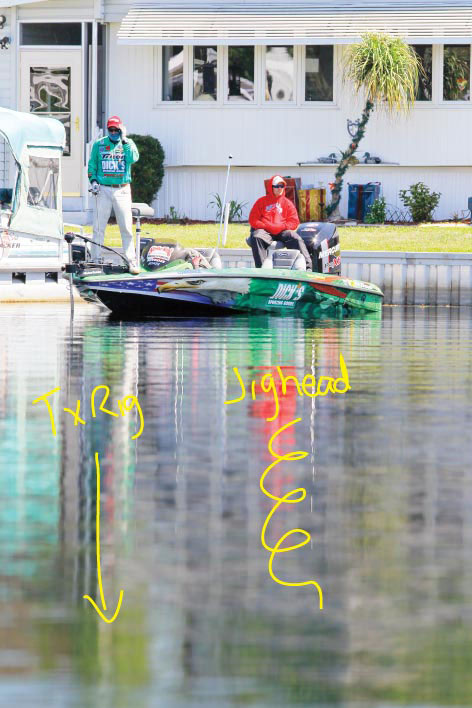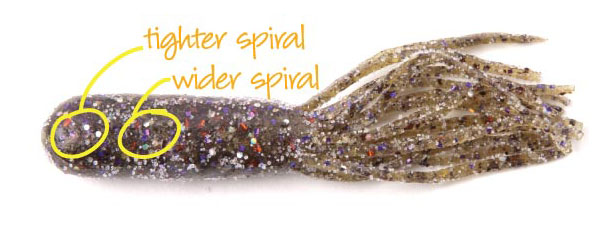
Longtime B.A.S.S.-watchers may remember Shaw Grigsby’s remarkable four-year stretch between 1988 and ’92 during which he won the Texas Bassmaster Invitational on Sam Rayburn Reservoir three times. What’s often forgotten is that the Florida pro won them all fishing a grass-filled lake in conditions that ranged from unseasonably cold to near hurricane-force winds to almost perfect; and, perhaps more significantly, that he used the same lure each time — a plastic tube.
Today, more than two decades later, Grigsby still keeps the hollow, squid-tail lures rigged and ready; his win in the 2011 Bassmaster Elite tournament on Florida’s Harris Chain included more than a few fish caught on tubes.
“The real secret to fishing a tube lure successfully is never limiting the way you fish it,” laughs Grigsby. “I really don’t know that there is a wrong way to fish them, or a time frame that limits when you fish them. Certainly, having confidence in a tube is extremely important, but once anyone starts using one of these lures, they quickly realize how versatile and how effective the bait really is.”
Part of that effectiveness, says Grigsby, comes from the fact that a tube mimics both a baitfish as well as a crawfish, two completely different forage species that bass relish. More importantly, the lure can be made to imitate both on the same cast. Grigsby has caught bass sight fishing tubes in a foot of water, and he’s caught others 30 feet deep crawling tubes on the bottom. He’s fished them weightless; he’s punched them through matted weeds with 1-ounce sinkers; and he’s fished them in both clear and dingy conditions. Denny Brauer and Woo Daves each won Bassmaster Classics on tubes, too.
Much of Grigsby’s reputation comes from his uncanny skill as a sight fisherman for spawning fish, and when he’s using a tube this way he Texas rigs with an unpegged 1/8-ounce bullet sinker on the line. His hook choice is a TroKar TK 190, a wide-gap hook specifically designed for tubes, and 8- or 10-pound Stren Fluorocast fluorocarbon line.
“I consider rigging a critical part of tube fishing anytime, because how you rig a tube determines the action it will have,” emphasizes Grigsby. “The reason I Texas rig is that the sinker takes the tube straight down to the bottom. In a bedding situation, you want a presentation that puts your lure in a specific spot, and the Texas rig does that. I also believe separating the weight from the lure may result in a few more strikes, too, but this is really personal preference.
“If you use a jighead, the tube will spiral down, and while this is a great action, you don’t know where it’s going.
“My weight choice for a sinker depends on the depth of water, the wind and my line size,” Grigsby says. “Basically, I use an 1/8-ounce sinker with my spinning gear, but with baitcasting tackle I move up to 3/16 or 1/4 ounce, because I use heavier 15- to 20-pound fluorocarbon. Now, if I’m flipping in heavy vegetation or punching through mats, I’ll use a 1-ounce or even a 1 1/4-ounce weight and 65-pound braid.”
Grigsby has always paid careful attention to his hook choices, as well. The majority of the time he’s fishing Strike King’s Coffee Tube or the Bleeding Tube, both of which match perfectly with a 4/0 TK 190. He rigs just like a worm, pushing the hook through the top of the head, bringing it out and then pulling it down and re-inserting it. The key is pushing the hook completely through both sides of the hollow body, then skin-hooking it to make the lure weedless. Leaving the hook inside the tube, as some anglers do, makes it much, much harder to get a solid hook set.
“Back in 1988 when I won my first event on Rayburn, I fished with an exposed hook because we didn’t have wide-gap hooks then,” remembers Grigsby. “I was fishing brush so I had to be extremely careful how I fished. If we had had these types of hooks back then, I really wonder how many more fish I might have caught.
“I still fish a tube with a jighead and an exposed hook, but only in open water, usually a Lake Erie or Champlain-type situation when I’m after smallmouth in slightly deeper depths. Tubes are famous for their spiraling fall, and this is what I want when I’m fishing these types of conditions. It’s a very natural movement that accurately duplicates the motions of a dying or injured baitfish.”
Grigsby uses either a jighead he rigs internally by sliding it up into the tube and pushing the line tie out through the wall; or he uses an internal tube weight like a small bell sinker and rigs it with the TroKar TK 190 hook. The small bell sinkers have a wire line-tie loop, and when the hook is pushed down through the tube head, Grigsby threads the barb through this line tie to make certain it stays in place, then finishes with his normal Texas rigging.
The size of the spiral can be controlled somewhat by the position of this bell sinker, or by the location of the internal jighead; the farther into the tube (closer to the head) either is placed, the tighter the spiral, while leaving it a little farther down in the tube will result in a wider spiral. Tighter spirals are better if you’re fishing in cover like standing timber, or in colder water, while wider spirals produce well in warmer, more open water.

“When you do want this spiral fall, make your cast and let the lure fall on a slack line with your reel in free-spool,” instructs the Florida pro. “Any tension on the line changes the fall and takes away its natural appearance. Most strikes will come as your tube is falling, too, so you want the most natural appearance possible.”
If his tube reaches the bottom without getting hit, Grigsby turns it into a crawfish simply by slowly crawling it along the bottom. A slow, steady crawl is nearly always better, he points out, because this is really how crawfish move. Occasionally, he may twitch his rod slightly just to flare the tube’s tentacles, but he doesn’t hop it or change speeds because those aren’t natural crawfish actions. When he feels the tube touching an object like a limb or rock, he stops dragging and shakes the bait gently just to draw attention to it.
How a tube falls depends on how you rig it. A Texas rigged bait will fall straight, while a tube with an internal jighead and exposed hook will spiral to the bottom.
One of Grigsby’s favorite presentations, and one he believes often generates reflex strikes, is skip-casting to shallow cover. Tubes are easy to skip because of their light weight and smooth, compact shape, and some of his favorite targets are boat docks, isolated bushes and stickups, stumpy points and even submerged vegetation. Grigsby believes bass hear the lure coming and will position themselves to strike as it splashes beside them. Other strikes come just as the tube begins spiraling down.
“Most of the time, you think of the skip-cast as a way to present a lure into a hard-to-reach place, such as underneath docks or overhanging tree limbs,” Grigsby says, “but I think this type of presentation can be a defining moment for a bass, because the tube imitates the exact movement and behavior of a minnow jumping out of the water as it tries to escape another predator.
“There is always competition between bass for food, and because this type of presentation is so lifelike, it just triggers that instinct to strike. During a tournament at Lake Murray, I rigged a tube weightless with just a hook and skipped it underneath docks, then retrieved it like a soft jerkbait and caught suspended bass. A skip-cast even produces strikes from surface schooling bass, even though they may be over deep water.”
Grigsby doesn’t hesitate to flip tubes into heavy cover, either, often citing fellow pro Denny Brauer’s 1998 Classic win as an example of how tubes can outperform jigs under certain conditions. In Brauer’s case, a jig produced well enough to give him the Classic lead heading into the third and final day of competition, but then the Missouri pro simply couldn’t buy a bite with the lure. He changed to a tube and started flipping into the very same shallow, visible cover he’d been working with the jig and caught enough fish to win comfortably.
“Jigs are somewhat bulky lures that certainly have a well-deserved reputation for catching bass in cover,” acknowledges Grigsby, “but after a couple of days, maybe the bass become accustomed to seeing it. Maybe they start to feel intimidated by it. Who knows what causes bass to stop biting like they do? When it happens with a jig, a tube is the perfect alternate choice because it behaves so differently.
“A tube, because it doesn’t have any appendages or even a long swimming tail, slides right into the cover, and if you have to shake it, the thin-strand tail flares and looks like it’s alive. Tubes aren’t intimidating lures at all, and bass, being the lazy creatures they are, simply swallow it.”

When a tube spirals down, it mimics an injured baitfish and can provoke strikes. You can adjust this spiral by placing the weight of the jighead in different positions within the tube.
The fact tubes do come through cover so easily is one reason Grigsby particularly likes them when he’s flipping matted vegetation. For this type of fishing, he Texas rigs with 65-pound braided line, a heavy sinker (this is when he often does peg it in place) of an ounce or more and changes his TK 190 hook for a heavier TK 130, which is designed for flipping. Even with this heavier outfit, bass often hit the tube as it breaks through the mat into the open water below, but if there are no strikes, Grigsby lets the tube hit bottom, then starts slowly crawling it along; he doesn’t jump it or hop it to create multiple falls.
While 4-inch tubes are his favorite all-around size, he occasionally uses the much larger 7-inch Tora Tubes if he’s targeting really big bass. Grigsby first tried them during the initial 2006 Bassmaster Elite Series event at Lake Amistad and can only describe them as “amazing and very specialized lures,” since they need huge 9/0 hooks and almost totally eliminate smaller fish. When Bobby Garland introduced his first tube, the Fat Gitzit, in 1964, it measured just 2 1/2 inches long, and for years that was the size Grigsby and the other pros used. Today, however, he seldom fishes tubes that small.
Not surprisingly, for one who has built his career around tubes – Grigsby learned how effective they were during the 1985 SuperBass tournament on the St. Johns River when paired with light tackle expert Guido Hibdon – he has designed both spinning and baitcasting rods specifically for the lure, and his 6-foot, 10-inch Tour Grigsby Spinning Rod by Quantum has proven to be extremely popular. It is short enough for skip-casting but also features a parabolic bend rather than a superfast tip. That parabolic bend not only permits skipping such a light lure, it also provides excellent hook setting with fluorocarbon line, which has very little stretch.
Those who know Grigsby well characterize him as a pretty basic, no-frills fisherman, and that definitely describes his approach to tube fishing. If he has a real secret of success with the lure that others can use, it is nothing more than having a huge dose of confidence in the bait. Yes, he recommends learning to skip-cast the lure and fishing it extremely slowly when it’s on the bottom, but overall, it’s recognizing just how versatile and effective tubes can be.
After all, he saw that more than 25 years ago, and he’s been a dedicated tube fisherman ever since.
B.A.S.S. Members can read the entire April issue online via Digital Bassmaster.




